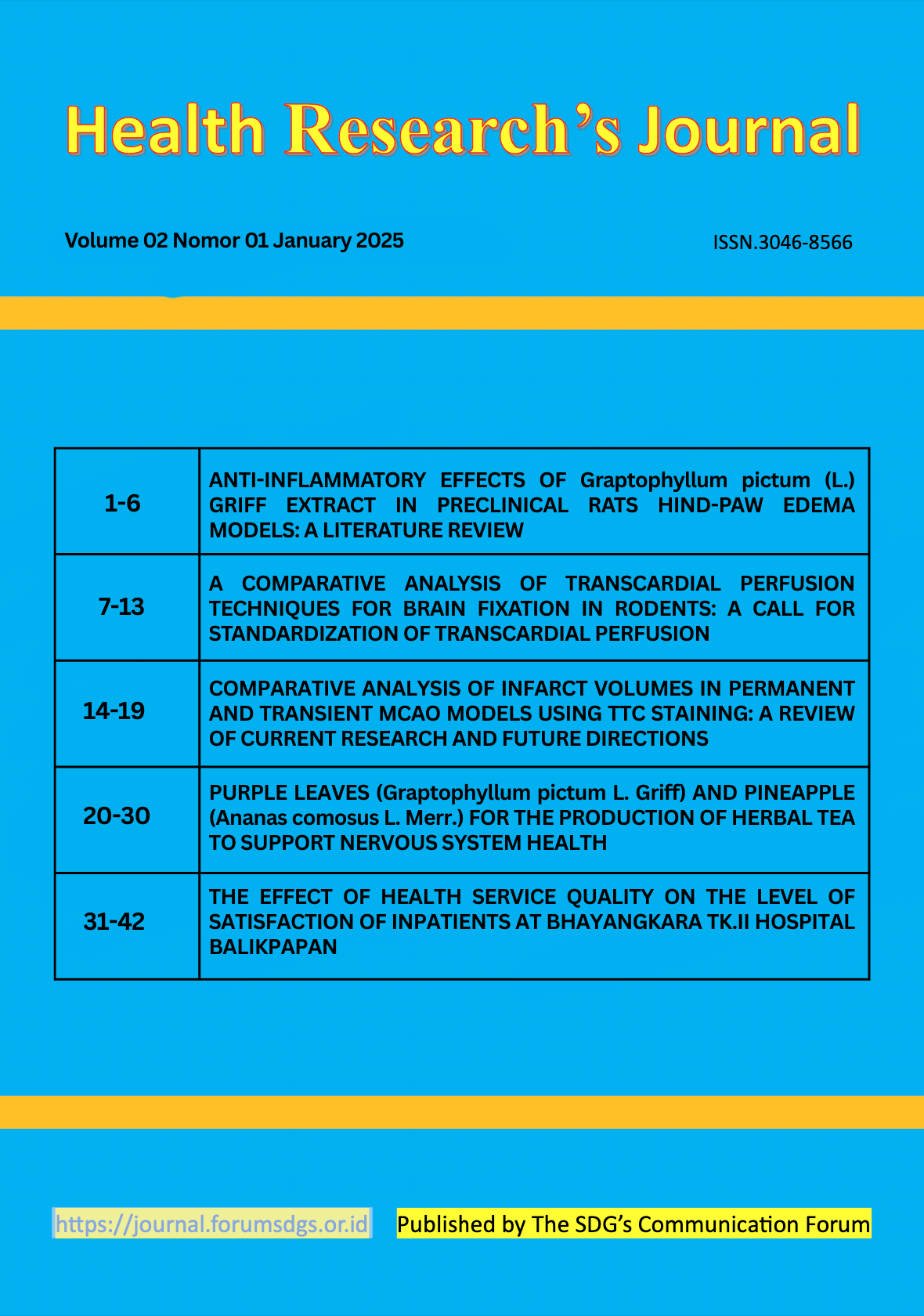PURPLE LEAVES (Graptophyllum pictum L. Griff) AND PINEAPPLE (Ananas comosus L. Merr.) FOR THE PRODUCTION OF HERBAL TEA TO SUPPORT NERVOUS SYSTEM HEALTH
DOI:
https://doi.org/10.00000/fadfe331Keywords:
Ananas comosus, food safety, functional beverages, Graptophyllum pictum, herbal tea, neuroprotection, phytochemicalAbstract
This study explores the potential of purple leaves and pineapple as raw materials for producing herbal tea. It examines the availability of these plants in Indonesia, analyzes their bioactive compounds, investigates the tea production process, and evaluates food safety through toxicity and microbiological testing. The research employs an experimental approach, integrating literature reviews, phytochemical analysis, and laboratory testing. The study involves identifying key bioactive compounds in purple leaves and pineapple, formulating an optimal tea blend, and conducting toxicity and microbial safety evaluations.The study finds that purple leaves contains flavonoids, alkaloids, and tannins, which possess neuroprotective and anti-inflammatory. Pineapple contains bromelain and vitamin C, which are known for their antioxidative and anti-inflammatory. This research provides a novel contribution by introducing a herbal tea formulation combining purple leaves and pineapple. It offers valuable insights into the potential of Indonesian herbal resources for functional food development and phytopharmacology.
References
BPOM RI. (2019). Regulation on Maximum Microbial Contamination in Food. BPOM Indonesia.
BPOM. (2020). Regulation on Herbal Medicine in Indonesia. National Agency of Drug and Food Control.
Chen, L., Deng, H., Cui, H., Fang, J., Zuo, Z., Deng, J., & Zhao, L. (2018). Inflammatory responses and inflammation-associated diseases in organs. Oncotarget, 9(6), 7204.
Chobotova, K., Vernallis, A. B., & Majid, F. A. A. (2010). Bromelain’s activity and potential as an anti-cancer agent. Journal of Medicinal Plants Research, 4(8), 673-681.
Cicero, A. F. G., Fogacci, F., & Colletti, A. (2018). Potential role of bioactive peptides in the prevention and treatment of chronic diseases: A narrative review. British Journal of Pharmacology, 175(8), 1312-1325.
EMA. (2019). Guideline on Herbal Medicinal Products. European Medicines Agency.
Gupta, S. C., et al. (2013). Therapeutic roles of curcumin. BioFactors, 39(1), 2-13.
Guyton, A. C., & Hall, J. E. (2016). Textbook of medical physiology (13th ed.). Elsevier.
Jang, S., Lee, K., & Kim, H. (2021). Neuroprotective effects of natural products targeting oxidative stress in neurodegenerative diseases. Antioxidants, 10(9), 1377.
Kandel, E. R., Schwartz, J. H., Jessell, T. M., Siegelbaum, S. A., & Hudspeth, A. J. (2021). Principles of Neural Science (6th ed.). McGraw-Hill.
Lobo, V., Patil, A., Phatak, A., & Chandra, N. (2010). Free radicals, antioxidants, and functional foods. Pharmacognosy Reviews, 4(8), 118-126.
OECD. (2019). Guidelines for the Testing of Chemicals: Acute Oral Toxicity.
Pacher, P., Beckman, J. S., & Liaudet, L. (2007). Nitric oxide and peroxynitrite in health and disease. Physiological Reviews, 87(1), 315-424.
Rahmawati, F., Santoso, A. D., & Widodo, M. A. (2021). The antioxidant and neuroprotective potential of Graptophyllum pictum. Journal of Medicinal Plants Research, 15(3), 45-53.
Santoso, A. D., Wijaya, K., & Kurniawan, A. (2020). Bromelain as a potential neuroprotective agent in oxidative stress-induced neurodegeneration. Neuroscience Letters, 740, 135413.
Singh, B., Singh, J. P., Kaur, A., & Singh, N. (2019). Phenolic composition of natural products. Food Chemistry, 289, 295-304.
Singh, R., Sharma, M., & Gupta, A. (2019). Herbal tea: A comprehensive review on health benefits and safety concerns. Journal of Herbal Medicine, 19, 100288.
WHO. (2013). WHO traditional medicine strategy: 2014-2023. World Health Organization.
Widyaningsih, R. D., Sari, R. P., & Susanto, H. (2021). Antioxidant effects of Graptophyllum pictum. Journal of Traditional Medicine, 45(2), 89-102.
Wu, X., Yang, Y., Dou, S., Wang, S., & Guo, L. (2020). Role of flavonoids in neuroprotection and neuroinflammation. Frontiers in Aging Neuroscience, 12, 236.
Zhang, et al. (2020). Processing of herbal teas. Food Science & Nutrition, 8(10), 5497-5506.
Zhang, X., Yin, W., & Wang, Y. (2017). Effects of flavonoids on neurotransmitter release and stress modulation. Neuropharmacology, 117, 219-231.


